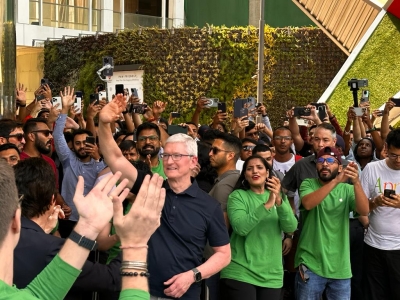Hong Kong, April 30 (IANS) When Tim Cook arrived in India earlier this month to open Apple’s first physical store in the country, he was welcomed like a hero, media reports said.
Cook’s visit, the latest by a top global executive, exemplifies the rising tide of interest that corporations and governments are showing in doing business with India, CNN reported.
Just days after his landmark trip, Pret A Manger, a trendy British sandwich chain, set up its first outlet in the commercial capital of Mumbai, as it bet on the country’s growing middle class, CNN reported.
The case for investing in India – a nation of 1.4 billion – is clear, and only bolstered by recent geopolitical shifts. As Western leaders look to boost economic cooperation with countries that share similar values, India, the world’s largest democracy, stands to gain.
Until recently, many countries and companies “had put all their eggs in the China basket”, said Partha Sen, professor emeritus at the Delhi School of Economics. As tensions continue to flare between the West and Beijing, there is “a move to diversify away, and India fits right into it,” he added, CNN reported.
India’s so-called “demographic dividend,” the potential economic growth arising from a large working-age population, represents a major opportunity. Its vast consumer market and pool of affordable labor is also drawing more attention from global brands and trading partners.
In a bid to boost the industrial sector and lift exports, the Indian government has sought to sign free trade deals, a move that’s been warmly received around the world.
Since 2021, India has struck agreements with Australia, the United Arab Emirates and Mauritius. It is also negotiating deals with the European Union, the United Kingdom and Canada, CNN reported.
Beyond geopolitics, India’s economic and demographic fundamentals are driving business interest, CNN reported.
The International Monetary Fund expects the South Asian nation to outperform all major emerging and advanced economies this year, logging GDP growth of 5.9 per cent. By comparison, the German and UK economies will stagnate, while the United States will grow only 1.6 per cent.
If it can maintain its momentum, India will overtake Germany as the world’s fourth largest economy in 2026 and knock Japan from the number three spot in 2032, according to analysis by the Centre for Economics and Business Research, CNN reported.
India’s working-age population stands at more than 900 million, according to 2021 data from the Organisation for Economic Cooperation and Development. In the next few years, its workforce could be bigger than China’s, according to Capital Economics, CNN reported.
–IANS
san/svn/






